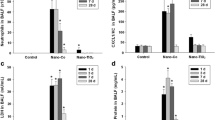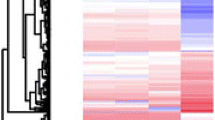Abstract
Inhalation of mixtures of insoluble and soluble nickel compounds by humans during nickel refining has been associated with excess lung and nasal sinus cancers. Insoluble nickel subsulfide (Ni3S2) and nickel oxide (NiO) are carcinogenic to rodents by inhalation. We previously showed that insoluble Ni3S2, crystalline nickel monosulfide (NiS), and green (high temperature, HT) and black (low temperature, LT) NiO, induced morphological transformation in cultured C3H/10T1/2 Cl 8 (10T1/2) mouse embryo cells. To understand molecular mechanisms of carcinogenesis by insoluble nickel compounds, we used random, arbitrarily primed-polymerase chain reaction (RAP-PCR) mRNA differential display and identified nine cDNA fragments that were differentially expressed between nontransformed and nickel-transformed cell lines in ~ 10.0% of the total mRNA. Expression of the calnexin gene (encoding a type I membrane protein/molecular chaperone), the ect-2 proto-oncogene, and the stress-inducible gene, Wdr1, was upregulated. Expression of six genes – the vitamin D interacting protein/thyroid hormone activating protein 80 (DRIP/TRAP-80) gene, the insulin-like growth factor receptor 1 (IGFR1) gene, the small nuclear activating protein (SNAP C3) gene, and three unknown genes, was down-regulated, in nickel-transformed cell lines. We hypothesize that these resulting aberrations in gene expression could contribute to the induction and/or maintenance of morphological transformation induced by specific insoluble nickel compounds.
Similar content being viewed by others
References
Sunderman FW Jr: Mechanisms of nickel carcinogenesis. Environ Health 15: 1–15, 1989
Oller AR, Costa M, Oberdorster G: Carcinogenicity assessment of selected nickel compounds. Toxicol Appl Pharmacol 143: 152–166, 1997
International Agency for Research on Cancer. IARC monographs on the evaluation of the carcinogenic risk of chemicals to humans. In: Cadmium, Nickel, Some Epoxides, Miscellaneous Industrial Chemicals, and General Considerations on Volatile Anaesthetics, Vol. II. Lyon, 1976
Report of the International Committee on Nickel Carcinogenesis in Man (ICNCM). Scand J Work Environ Health 16: 1–82, 1990
Ottolenghi AD, Haseman JK, Payne WW, Falk HL, MacFarland HN: Inhalation studies of nickel sulfide in pulmonary carcinogenesis or rats. J Nat Cancer Inst 54: 1165–1172, 1974
Sunderman FW Jr, Maenza RM: Comparisons of carcinogenicities of nickel compounds in rats. Res Commun Chem Pathol Pharmacol 14: 319–330, 1976
Kasprzak K, Gabryel P, Jarczewska K: Carcinogenicity of nickel(II) hydroxides and nickel(II) sulfate in Wistar rats and its relation to the in vitro dissolution rates. Carcinogenesis 4: 275–279, 1983
NTP (National Toxicology Program): Toxicology and carcinogenesis studies of nickel subsulfide in F 344/N rats and B6C3F1 mice. Draft Technical Report, NTR TR 453, NIH Publication No. 94-3369, Bethesda, Maryland, 1994a
NTP (National Toxicology Program): Toxicology and carcinogenesis studies of nickel oxide in F 344/N rats and B6C3F1 mice. Draft Technical Report, NTR TR 451, NIH Publication No. 94-3363, Bethesda, Maryland, 1994a,b
NTP (National Toxicology Program): Toxicology and carcinogenesis studies of nickel sulfate hexahydrate in F 344/N rats and B6C3F1 mice. Draft Technical Report, NTR TR 454, NIH Publication No. 94-3370, Bethesda, Maryland, 1994a,b)
Ciccarelli RB, Wetterhahn KE: Nickel bound to chromatin, nucleic acids, and nuclear proteins from kidney and liver of rats treated with nickel carbonate in vivo. Cancer Res 44: 3892–3897, 1984
Andersen O: Evaluation of the spindle-inhibiting effect of Ni2+ by quantitation of chromosomal super-contraction. Res Commun Chem Pathol Phamacol 500: 379–386, 1985
Ciccarelli RB, Wetterhahn KE: Nickel distribution and DNA lesions induced in rat tissue by the carcinogenic nickel carbonate. Cancer Res 42: 3544–3549, 1982
Verma R, Ohshima S, Ramnath J, Kaspin L, Landolph JR: Determination of relative in vitro genotoxicities of insoluble nickel compounds in C3H/10T1/2 mouse embryo fibroblasts: Correlations with carcinogenicity, prediction of carcinogenic potentials, and implications for molecular mechanisms of nickel carcinogenesis (manuscript in preparation)
Nishimura M, Umeda M: Induction of chromosomal aberrations in cultured mammalian cells by nickel compounds. Mutat Res 68: 337–349, 1979
Sunderman FW: Recent research on nickel carcinogenesis. J Environ Health Perspect 40: 131–141, 1981
Klein CB, Conway K, Wang XW, Bhamra R, Lin X, Cohen MD, Annab L, Barrett JC, Costa M: Senescence of nickel-transformed cells by an X chromosome: Possible epigenetic control. Science 251: 796–799, 1991
Biedermann KA, Landolph JR: Induction of anchorage independence in human diploid foreskin fibroblasts by carcinogenic metal salts. Cancer Res 47: 3815–3823, 1987
Miura T, Patierno S, Sakuramoto T, Landolph JR: Morphological and neoplastic transformation of C3H/10T1/2 mouse embryo cells by insoluble carcinogenic nickel compounds. Environ Mol Mutagen 14: 65–78, 1989
Costa M: Mechanisms of nickel genotoxicity and carcinogenicity. In: L.W. Chang, L. Magos, T. Suzuki (eds). Toxicology of Metals, Chapter 15. CRC Lewis Publishers Press, Boca Raton, Florida, 1996, pp 245–251
Landolph JR: Molecular and cellular mechanisms of transformation of C3H/10T1/2 Cl 8 and diploid human fibroblasts by unique carcinogenic, non-mutagenic metal compounds: A review. Biol Trace Element Res 21: 459–467, 1989
Landolph JR: Neoplastic transformation of mammalian cells by carcinogenic metal compounds: Cellular and molecular mechanisms. In: E.C. Foulkes (ed). Biological Effects of Heavy Metals, Vol. II: Carcinogenesis. Chapter 1. CRC Press, Boca Raton, Florida, 1990, pp 1–18
Landolph JR: Molecular mechanisms of transformation of C3H/10T1/2 Cl 8 mouse embryo cells and diploid human fibroblasts by carcinogenic metal compounds. Environ Health Perspect 102(suppl 3): 119–125, 1994
Landolph JR, Dews M, Ozbun L, Evans DP: Metal-induced gene expression and neoplastic transformation. In: L.W. Chang, L. Magos, T. Suzuki (eds). Toxicology of Metals, Chapter 19. CRC Lewis Publishers, Boca Raton, Florida, 1996, pp 321–329
Landolph JR: Role of free radicals in metal-induced carcinogenesis. In: A. Sigel, H. Sigel (eds). Metal Ions in Biological Systems, Volume 36: Interrelations Between Free Radicals and Metal Ions in Life Processes, Chapter 14. Publishers 1999, pp 445–484
Landolph JR: The role of free radicals in chemical carcinogenesis. In: C.J. Rhodes (ed). Toxicology of the Human Environment. The Critical Role of Free Radicals. Chapter 17. Taylor and Francis, London/New York, 2000, pp 339–362
Reznikoff CA, Brankow DW, Heidelberger C: Establishment and characterization of a cloned line of C3H mouse embryo cells sensitive to postconfluence inhibition of division. Cancer Res 33: 3231–3238, 1973a
Reznikoff CA, Bertram JS, Brankow DW, Heidelberger C: Quantitative and qualitative studies of chemical transformation of cloned C3H mouse embryo cells sensitive to postconfluence inhibition of cell division. Cancer Res 33: 3239–3249, 1973b
Landolph JR: Chemical carcinogens produce mutations to ouabain resistance in transformable C3H/10T1/2 Cl 8 mouse fibroblasts. Proc Natl Acad Sci USA 76: 930–934, 1979
Landolph JR: Chemical transformation in C3H//10T1/2 Cl 8 mouse embryo fibroblasts: Historical background, assessment of the transformation assay protocol, and evolution and optimization of the transformation assay protocol. In: T. Kakunaga, H. Yamasaki (eds). Transformation Assay of Established Cell Lines: Mechanisms and Application. IARC Scientific Publication No. 67. International Agency for Cancer Research, Lyon, France, 1985, pp 185–198
Liang P, Bauer D, Averboukh L, Warthoe P, Rohrwild M, Muller H, Strauss M, Pardee AB: Analysis of altered gene expression by differential display. Meth Immunol 254: 304–321, 1995
McClelland M, Welsh J: RNA fingerprinting by arbitrarily primed PCR. In: PCR Methods and Applications, Vol. 4: Cold Spring Harbor Laboratory, 1994, pp S66–S81
Liang L, Pardee AB: Recent advances in differential display. Curr Opin Immunol 7: 274–280, 1995
Ora A, Helenius A: Calnexin fails to associate with substrate proteins in gluconidase-deficient cell lines. J Biol Chem 270: 26060–256062, 1995
Galvin K, Krishna S, Pnochel F, Frohlich M, Cummings DE, Carlson R, Wands JR, Isselbacher KJ, Pillai S, Ozturk M: The major histocompatibility complex class I antigen-binding protein p88 is the product of calnexin gene. Proc Natl Acad Sci 89: 8452–8456, 1992
Tjoelker LW, Seyfried CE, Eddy RL Jr, Byers MG, Shows TB, Calderon J, Schrieber RB, Gray PW: Human, mouse, and rat calnexin cDNA cloning: Identification of potential calcium binding motifs and gene localization to human chromosome 5. Biochemistry 33: 3229–3236, 1994
Schreiber KL, Bell MP, Huntoon CJ, Rajagopalan S, Brenner MB, McKean DJ: Class II histocompatibility molecules associate with calnexin during assembly in the endoplasmic reticulum. Int Immunol 6: 101–111, 1994
Honore B, Rasmussen HH, Celis A, Leffers H, Madsen P, Celis JE: The molecular chaperones HSP28, GRP78, andoplasmin, and calnexin exhibit strikingly different levels in quiescent keratinocytes as compared to their proliferating normal and transformed counterparts; cDNA cloning and expression of calnexin. Electrophoresis 15: 482–490, 1999
Zhou D, Salnikow K, Costa M: Cap43, a novel gene specifically induced by Ni2+ compound. Cancer Res 58: 2182–2189, 1998
Ito M, Yuan C, Malik S, Gu W, Fondell JD, Yamamura S, Fu Z, Zhang X, Qin J, Roeder RG: Identity between TRAP and SMCC complexes indicates novel pathways for the function of nuclear receptors and diverse mammalian activators. Mol Cell 3: 361–370, 1999
Rachez C, Lemon BD, Suldan Z, Bromleigh V, Gamble M, Naar AM, Erdjument-Bromage H, Tempst P, Freedman LP: Ligand-dependent transcription activation by nuclear receptors requires the DRIP complex. Nature 398: 824–827, 1999
Rachez C, Suldan Z, Ward J, Chang CB, Burakov D, Edrjument-Bromage H, Tempst P, Freedman LP: A novel protein complex that interacts with the vitamin D3 receptor in a ligand-dependent manner and enhances VDR transactivation in a cell-free system. Genes Dev 12: 1787–1800, 1998
Miki T, Smith CL, Long JE, Eva A, Fleming TP: Oncogene ect2 is related to regulators of small GTP-binding proteins Nature 362: 462–465, 1993
Adler HJ, Winnicki RS, Gong TL, Lomax MI: A gene upregulated in the acoustically damaged chick basilar papilla encodes a novel WD40 repeat protein. Genomics 56: 59–69, 1999
Landolph JR, Verma A, Ramnath J, Clemens F: Molecular biology of deregulated gene expression in transformed C3H/10T1/2 mouse embryo cell lines induced by specific insoluble carcinogenic nickel compounds. Environ Health Perspect 110(suppl 5): 845–850, 2002
Author information
Authors and Affiliations
Corresponding author
Rights and permissions
About this article
Cite this article
Verma, R., Ramnath, J., Clemens, F. et al. Molecular biology of nickel carcinogenesis: Identification of differentially expressed genes in morphologically transformed C3H10T1/2 Cl 8 mouse embryo fibroblast cell lines induced by pecific insoluble nickel compounds. Mol Cell Biochem 255, 203–216 (2004). https://doi.org/10.1023/B:MCBI.0000007276.94488.3d
Issue Date:
DOI: https://doi.org/10.1023/B:MCBI.0000007276.94488.3d




